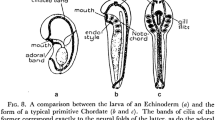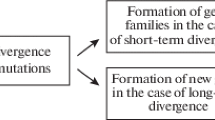Abstract
Evolutionary theory has been likened to a “universal acid” (Dennett 1995) that eats its way into more and more areas of science. Recently, developmental biology has been infused by evolutionary concepts and perspectives, and a new field of research—evolutionary developmental biology—has been created and is often called EvoDevo for short. However, this is not the first attempt to make a synthesis between these two areas of biology. In contrast, beginning right after the publication of Darwin’s Origin in 1859, Ernst Haeckel formulated his biogenetic law in 1872, famously stating that ontogeny recapitulates phylogeny. Haeckel was in his turn influenced by pre-Darwinian thinkers such as Karl Ernst von Baer, who had noted that earlier developmental stages show similarities not seen in the adults. In this review, written for an audience of non-specialists, we first give an overview of the history of EvoDevo, especially the tradition emanating from Haeckel and other comparative embryologists and morphologists, which has often been neglected in discussions about the history of EvoDevo and evolutionary biology. Here we emphasize contributions from Russian and German scientists to compensate for the Anglo-American bias in the literature. In Germany, the direct influence of Ernst Haeckel was felt particularly in Jena, where he spent his entire career as a professor, and we give an overview of the “Jena school” of evolutionary morphology, with protagonists such as Oscar Hertwig, Ludwig Plate, and Victor Franz, who all developed ideas that we would nowadays think of as belonging to EvoDevo. Franz ideas about “biometabolic modi” are similar to those of a Russian comparative morphologist that visited Jena repeatedly, A. N. Sewertzoff, who made important contributions to what we now call heterochrony research—heterochrony meaning changes in the relative timing of developmental events. His student I. I. Schmalhausen became an important contributor to the synthetic theory of evolution in Russia and is only partly known outside of the Russian-reading world because only one of his many books was translated into English early on. He made many important contributions to evolutionary theory and we point out the important parallels between Schmalhausen’s ideas (stabilizing selection, autonomization) and C. H. Waddington’s (canalization, genetic assimilation). This is one of the many parallels that have contributed to an increased appreciation of the internationality of progress in evolutionary thinking in the first half of the twentieth century. A direct link between German and Russian evolutionary biology is provided by N. V. Timoféeff-Ressovsky, whose work on, e.g., fly genetics in Berlin is a crucial part of the history of evo-devo. To emphasize the international nature of heterochrony research as predecessor to the modern era of EvoDevo, we include Sir G. R. de Beer’s work in the UK. This historical part is followed by a short review of the discovery and importance of homeobox genes and of some of the major concepts that form the core of modern EvoDevo, such as modularity, constraints, and evolutionary novelties. Major trends in contemporary EvoDevo are then outlined, such as increased use of genomics and molecular genetics, computational and bioinformatics approaches, ecological developmental biology (eco-devo), and phylogenetically informed comparative embryology. Based on our survey, we end the review with an outlook on future trends and important issues in EvoDevo.






Similar content being viewed by others
References
Alberch P (1980) Ontogenesis and morphological diversification. Amer Zool 20:653–667
Alberch P (1989) The logic of monsters: evidence for internal constraint in development and evolution. Geobios (Paris) 12:21–57
Alberch P, Gould SJ, Oster GF, Wake DB (1979) Size and shape in ontogeny and phylogeny. Paleobiol 5:296–317
Arthur W (2000) Intraspecific variation in developmental characters: the origin of evolutionary novelties. Amer Zool 40:811–818
Arthur W (2002) The emerging conceptual framework of evolutionary developmental biology. Nature 415:757–764
Blumenfeld LA, Bogdanov YF, Ivanov VI, Lyapunova NA (2000) Pioneer of molecular genetics. Mol Biol 34:955–957
Brigandt I (2006) Homology and heterochrony: the evolutionary embryologist Gavin Rylands de Beer (1899–1972). J Exp Zool B Mol Dev Evol 306:317–328
Carroll SB, Grenier JK, Weatherbee SD (2005) From DNA to diversity. Molecular genetics and the evolution of animal design, 2nd edn. Blackwell, Oxford
Coleman W (1962) Georges Cuvier, zoologist. Harvard University Press, Cambridge
Darwin C (1871) The descent of man, and selection in relation to sex, 2 vols. Murray, London
Davidson E (2001) Genomic regulatory networks. Academic, San Diego
de Beer GR (1930) Embryology and evolution. Clarendon, Oxford
de Beer GR (1932) Book review: A.N. Sewertzoff “Morphologische Gesetzmässigkeiten der evolution”. Nature 129:490–491
Dennett D (1995) Darwin’s dangerous idea: evolution and the meanings of life. Simon and Schuster, New York
Eco U (1966) Narrative structure in Fleming. In: Eco U (ed) The Bond affair. Reprinted (1992) in Glenwood Irons (ed) Gender, language and myth: essays on popular narrative. Toronto University Press, Toronto, pp 157–182
Fortey R (2008) Dry store room no 1: the secret life of the natural history museum. Harper, London
Franz V (1924) Geschichte der Organismen. Gustav Fischer, Jena
Franz V (1934) Die stammesgeschichtliche zunehmende Arbeitsersparnis beim Akkomodationsapparat des Wirbeltierauges. Ein Baustein zur Vervollkommnung der Organismen. Biol Zentbl 54:403–418
Garstang W (1922) The theory of recapitulation. A critical restatement of the biogenetic law. J Linn Soc Lond Zool 35:81–101
Gehring WJ (1998) Master control genes in development and evolution: the homeobox story. Yale University Press, New Haven
Geison GL, Holmes FL (eds) (1993) Research schools. Historical reappraisals. Osiris 8. Chicago University Press, Chicago
Gilbert SF (1994) Dobzhansky, Waddington, and Schmalhausen: embryology and the modern synthesis. In: Adams MB (ed) The evolution of Theodosius Dobzhansky. Princeton University Press, Princeton
Gilbert SF (2001) Ecological developmental biology: developmental biology meets the real world. Dev Biol 233:1–12
Gilbert SF (2003) The morphogenesis of evolutionary developmental biology. Int J Dev Biol 47:467–477
Goswami A, Weisbecker V, Sanchez-Villagra MR (2009) Developmental modularity and the marsupial–placental dichotomy. J Exp Zool B Mol Dev Evol 312B:186–195
Gould SJ (1974) The origin and function of ‘bizarre’ structures: antler size and skull size in the ‘Irish elk’, Megaloceros giganteus. Evolution 28:191–220
Gould SJ (1977) Ontogeny and phylogeny. The Belknap Press of Harvard University Press, Cambridge
Gould SJ (1989) Wonderful life: Burges shale and the nature of history. Norton, New York
Gulick JT (1905) Evolution, racial and habitudial. Carnegie Institution, Washington
Haeckel E (1866) Generelle Morphologie der Organismen, 2 vols.—i. Allgemeine Anatomie der Organismen; ii: Allgemeine Entwicklungsgeschichte der Organismen. Georg Reimer, Berlin
Haeckel E (1872) Monographie der Kalkschwämme, 3 vols. Georg Reimer, Berlin
Haeckel E (1874) Anthropogenie oder Entwickelungsgeschichte des Menschen. Gemeinverständliche wissenschaftliche Vorträge über die Grundzüge der menschlichen Keimes- und Stammesgeschichte. Wilhelm Engelmann, Leipzig
Haeckel E (1920) Natürliche Schöpfungsgeschichte. Walter de Gruyter, Berli
Hall BK (1984) Development mechanisms underlying the formation of atavisms. Biol Rev Camb Philos Soc 59:89–124
Hall BK (1995) Atavisms and atavistic mutations. Nat Genet 10:126–127
Hall BK (1998) Evolutionary developmental biology 2nd edn. Kluwer Academic, Dordrecht
Hall BK (2000) Guest editorial: evo-devo or devo-evo—does it matter? Evol Dev 2:177–178
Hall BK, Olson WM (eds) (2003) Keywords and concepts in evolutionary developmental biology. Harvard University Press, Cambridge
Hertwig O (1916) Das Werden der Organismen. Eine Widerlegung von Darwins Zufallstheorie durch das Gesetz der Entwicklung. Gustav Fischer, Jena
Hertwig O (1918) Zur Abwehr des ethischen, des sozialen, des politischen Darwinismus. Gustav Fischer, Jena
Hertwig O, Hertwig R (1882) Die Coelomtheorie. Jena Z Naturwiss 15:1–150
His W (1874) Unsere Körperform und das physiologische problem ihrer Entstehung. Briefe an einen befreundeten Naturforscher. F. C. W. Vogel, Leipzig
Hoekstra HE, Coyne JA (2007) The locus of evolution: evo devo and the genetics of adaptation. Evolution 61:995–1016
Hoßfeld U, Olsson L (2002) From the modern synthesis to lysenkoism, and back? Science 297:55–56
Hoßfeld U, Olsson L (2003) The road from Haeckel. The Jena tradition in evolutionary morphology and the origin of “evo-devo”. Biol Philos 18:285–307
Hoßfeld U, Olsson L, Breidbach O (ed) (2003) Carl Gegenbaur and evolutionary morphology. Theory Biosci, vol. 122, Heft 2/3
Hoßfeld U, Olsson L, Levit GS, Breidbach O (2010) Ivan I. Schmalhausen. Die Evolutionsfaktoren (Eine Theorie der stabilisierenden Auslese). Franz Steiner, Stuttgart
Huxley JS, de Beer GR (1934) The elements of experimental embryology. Cambridge University Press, Cambridge
Jägersten G (1955) On the early phylogeny of the metazoa. The bilaterogastraea theory. Zool Bidr Upps 30:321–354
Jägersten G (1959) Further remarks on the early phylogeny of the metazoa. Zool Bidr Upps 33:79–108
Jägersten G (1968) Livscykelns evolution hos metazoa. En generell teori. Scandinavian University Books, Stockholm
Jägersten G (1972) Evolution of the metazoan life cycle: a comprehensive theory. Scandinavian University Books, Stockholm
Junker T (2004) Die zweite Darwinsche Revolution. Geschichte des synthetischen Darwinismus in Deutschland 1924 bis 1950 (Acta Biohistorica, Bd. 8). Basilisken-Presse, Marburg
Junker T, Hoßfeld U (2009) Die Entdeckung der Evolution. Eine revolutionäre Theorie und ihre Geschichte. 2nd ed. WBG, Darmstadt
Kamshilov MM (1974) O gipoteze zameny phenokopij genokopijami. In: Zavadsky KM, Gall JM (eds) Istorija i teorija evoliutzionnogo uchenija. Evoliutzionnyje vzgliady ii schmalhausena. Akademy Nauka SSSR, Leningrad
Kirschner MW, Gerhard JC (1998) Evolvability. Proc Nat Acad Sci USA 95:8420–8427
Kirschner MW, Gerhard JC (2005) The plausibility of life: resolving Darwin’s dilemma. Yale University Press, New Haven
Levit GS (2007) The roots of evo-devo in Russia: is there a characteristic “Russian tradition”? Theory Biosci 126(4):131–148
Levit GS, Hoßfeld U (2006) The forgotten “Old-Darwinian” synthesis: the theoretical system of Ludwig H. Plate (1862–1937). NTM, NS 14:9–25
Levit GS, Hoßfeld U (2009) From molecules to the biosphere: Nikolai v. Timofeeff-Ressovsky’s (1900–1981) research program within a totalitarian landscape. Theory Biosci 128:237–248
Levit GS, Hoßfeld U, Olsson L (2004) The integration of Darwinism and evolutionary morphology: Alexej Nikolajevich Sewertzoff (1866–1936) and the developmental basis of evolutionary change. J Exp Zool B Mol Dev Evol 302:343–354
Levit GS, Hoßfeld U, Olsson L (2006) From the “Modern synthesis” to cybernetics: Ivan Ivanovich Schmalhausen (1884–1963) and his research program for a synthesis of evolutionary and developmental biology. J Exp Zool B Mol Dev Evol 306:89–106
Liao B-Y, Weng M-P, Zhang J (2010) Constrasting genetic paths to morphological and physiological evolution. Proc Nat Acad Sci USA 107:7353–7358
Lodish H et al (2003) Molecular cell biology. Freeman, New York
Love AC (2006) Evolutionary morphology and evo-devo: hierarchy and novelty. Theory Biosci 124:317–333
Love AC (2009) Marine invertebrates, model organisms, and the modern synthesis: epistemic values, evo-devo, and exclusion. Theory Biosci 128:19–42
Love AC, Raff RA (2003) Knowing your ancestors: themes in the history of evo-devo. Evol Dev 5:327–330
Matsuda R (1987) Animal evolution in changing environments with special reference to abnormal metamorphosis. Wiley, New York
Mayr E (1963) Animal species and evolution. Harvard University Press, Cambridge
Mayr E, Provine WB (eds) (1980) The evolutionary synthesis: perspectives on the unification of biology. Harvard University Press, Cambridge
Mocek R (1974) Wilhelm Roux—Hans Driesch. Zur Geschichte der Entwicklungsphysiologie der Tiere. Gustav Fischer, Jena
Mocek R (1998) Die werdende Form. Eine Geschichte der kausalen Morphologie. Basilisken-Presse, Marburg
Moczek AP (2008) On the origins of novelty in development and evolution. BioEssays 30:432–447
Müller F (1864) Für Darwin. Wilhelm Engelmann, Leipzig
Müller GB (2007) Evo-devo: extending the evolutionary synthesis. Nat Rev Genet 8:943–949
Müller GB, Wagner GP (1991) Novelty in evolution: restructuring the concept. Ann Rev Ecolog Syst 22:229–256
Nielsen C (2001) Animal evolution: interrelationships of the living phyla, 2nd edn. Oxford University Press, Oxford
Nielsen C, Nørrevang A (1985) The trochaea theory: an example of life cycle phylogeny. In: Conway S, Morris JDG, Gibson R, Platts HM (eds) The origin and relationships of lower invertebrates. Oxford University Press, Oxford, pp 28–41
Nöthlich R, Wetzel N, Hoßfeld U, Olsson L (2006) “Ich acquirierte das Schwein sofort, ließ nach dem Niederstechen die Pfoten abhacken u. schickte dieselben an Darwin”—der Briefwechsel von Otto Zacharias mit Ernst Haeckel (1874–1898). Ann Hist Philos Biol 11:177–248
Olsson L (2007) A clash of traditions: the history of comparative and experimental embryology in Sweden as exemplified by the research of Gösta Jägersten and Sven Hörstadius. Theory Biosci 126:117–129
Olsson L, Hoßfeld U (2007) Die Entwicklung: Die Zeit des Lebens. Ausgewählte Themen zur Geschichte der Entwicklungsbiologie. In: Höxtermann E, Hilger H (eds) Lebenswissen. Eine Einführung in die Geschichte der Biologie. Natur & Text, Rangsdorf, pp 218–243
Olsson L, Hoßfeld U, Breidbach O (2006) From evolutionary morphology to the modern synthesis and “evo-devo”: historical and contemporary perspectives. Theory Biosci 124:259–263
Olsson L, Hoßfeld U, Breidbach O (2009) Preface: between Ernst Haeckel and the homeobox: the role of developmental biology in explaining evolution. Theory Biosci 128:1–5
Peters DS (1980) Das biogenetische Grundgesetz—Vorgeschichte und Folgerungen. Medizinhist J 15:57–69
Pigliucci M (2008) What, if anything, is an evolutionary novelty? Philos Sci 75:887–898
Pigliucci M, Müller GB (eds) (2010) Evolution: the extended synthesis. MIT, Cambridge
Raff R (1996) The shape of life: genes, development, and the evolution of animal form. Chicago University Press, Chicago
Raff RA, Love AC (2004) Kowalevsky, comparative evolutionary embryology, and the intellectual lineage of evo-devo. J Exp Zool B Mol Dev Evol 302:19–34
Raff RA, Arthur W, Carroll SB, Coates MI, Wray G (1999) Chronicling the birth of a discipline. Evol Dev 1:1–2
Rasskin-Gutman D, De Renzi M (eds) (2009) Pere Alberch. The creative trajectory of an evo-devo. Publicaciones de la Universidad de Valencia, Valencia
Rehkämpfer G (1997) Zur frühen Rezeption von Darwins Selektionstheorie und deren Folgen für die vergleichende Morphologie heute. Sudhoffs Arch 81:171–192
Reif W-E, Junker T, Hoßfeld U (2000) The synthetic theory of evolution: general problems and the German contribution to the synthesis. Theory Biosci 119:41–91
Riedl R (1978) Order in living organisms: a systems analysis of evolution. Wiley, New York
Schlosser G (2002) Modularity and the units of evolution. Theory Biosci 121:1–80
Schlosser G, Wagner GP (eds) (2004) Modularity in development and evolution. University of Chicago Press, Chicago
Schmalgausen II (1983) Izbrannyje trudy. Puti i zakonomernosti evoliutzionnogo prozessa. Nauka, Moscow
Schmalgausen II (1988) Ivan Ivanovich Schmalhausen (1884–1963). Nauka, Moscow
Schmalhausen II (1938) Organizm kak tseloje v individual’nom i istoricheskom razvitii. Akademy Nauka SSSR, Leningrad
Schmalhausen II (1946) Faktory Evoliutzii. Akademy Nauka SSSR, Leningrad
Schmalhausen II (1949) Factors of evolution: the theory of stabilizing selection. Blakiston (reprinted in 1986 by Chicago Univ. Press), Philadelphia
Schmalhausen II (1968) The origin of terrestrial vertebrates. Academic, New York
Schmalhausen II (1969) Problemy darwinizma. Nauka, Leningrad
Schmalhausen II (1990) Voprosy darwinisma. Neopublikovannyje raboty. Nauka, Moscow
Schwenk K, Wagner GP (2003) Constraint. In: Hall BK, Olson WM (eds) Keywords and concepts in evolutionary developmental biology. Harvard University Press, Cambridge, pp 53–61
Sewertzoff AN (1929) Directions of evolution. Acta Zool 10:59–141
Sewertzoff AN (1931) Morphologische Gesetzmäßigkeiten der Evolution. Gustav Fischer, Jena
Sewertzoff AN (1949) Sobranije sotchinenij. V. 5. Izd. Akad. Nauk, Moscow
Sommer RJ (2009) The future of evo-devo: model systems and evolutionary theory. Nat Rev Genet 10:416–422
Starck D (1965) Vergleichende Anatomie der Wirbeltiere von Gegenbaur bis heute. Verh. Dtsch. Zool. Ges. in Jena (1965):51–67
Stern DL, Orgogozo V (2008) The loci of evolution: how predictable is genetic evolution? Evolution 62:2155–2177
Timoféeff-Ressovsky NW (1939) Genetik und Evolution (Bericht eines Zoologen). Z Indukt Abstamm Vererbungsl 76:158–219
Timoféeff-Ressovsky NW, Voroncov NN, Jablokov AV (1975) Kurzer Grundriss der Evolutionstheorie. VEB Gustav Fischer, Jena
Trienes R (1989) Type concept revisited: a survey of German idealistic morphology in the first half of the twentieth century. Hist Philos Life Sci 11:23–42
Ulrich W (1968) Ernst Haeckel: ‘Generelle Morphologie’, 1866 (Fortsetzung und Schluß). Zool Beitr N F 14:213–311
Uschmann G (1953) Einige Bemerkungen zu Haeckels biogenetischem Grundgesetz. Urania 16:131–138
Uschmann G (1959) Geschichte der Zoologie und der zoologischen Anstalten in Jena 1779–1919. Gustav Fischer, Jena
Uschmann G (1966) 100 Jahre ‘Generelle Morphologie’. Biol Rundsch 5:241–252
von Dassow G, Munro E (1999) Modularity in animal development and evolution: elements of a conceptual framework for evodevo. J Exp Zool 285:307–325
Waddington CH (1975) The evolution of an evolutionist. Cornell University Press, Ithaca
Wagner GP, Larsson HC (2003) What is the promise of developmental evolution? III. The crucible of developmental evolution. J Exp Zool B Mol Dev Evol 300:1–4
Wagner GP, Laubichler MD (2004) Rupert Riedl and the re-synthesis of evolutionary and developmental biology: body plans and evolvability. J Exp Zool B Mol Dev Evol 302B:92–102
Wagner GP, Lynch VJ (2009) Evolutionary novelties. Curr Biol 20:R48–R52
Wake DB (1996) Schmalhausen’s evolutionary morphology and its value in formulating research strategies. In: Systematic biology as an historical science. Memorie della società Italiana di scienze naturali e del museo civico di storia naturale di Milano, vol 27, pp 129–132
Wallace B (1986) Can embryologists contribute to an understanding of evolutionary mechanisms? In: Bechtel W (ed) Integrating scientific disciplines. M. Nijhoff, Dordrecht, pp 149–163
Weindling P (1991) Darwinism and social darwinism in imperial Germany: the contribution of the cell biologist Oscar Hertwig (1849–1922). Gustav Fischer, Stuttgart
West-Eberhard MJ (2003) Developmental plasticity and evolution. Oxford University Press, Oxford and New York
Wimsatt WC (1986) Developmental constraints, generative entrenchment, and the innate–acquired distinction. In: Bechtel W (ed) Integrating scientific disciplines. M. Nijhoff, Dordrecht, pp 185–208
Wray GA (2007) The evolutionary significance of cis-regulatory mutations. Nat Rev Genet 8:206–216
Acknowledgements
We thank the Deutsche Forschungsgemeinschaft (grant no. HO 2143, 9-1) for generous support of our research into the history of EvoDevo and several anonymous reviewers for very helpful comments that improved the paper substantially. LO’s empirical EvoDevo research is funded by the Deutsche Forschungsgemeinschaft (grants no. OL 134/2-4 and 138/1). Work in Swedish archives by LO and UH was supported by The Center for History of Science at the Royal Swedish Academy of Sciences in Stockholm. This paper was written when LO was a short-term visiting scientist at NESCent at Duke University in Durham, NC, USA, and at the KLI (Konrad-Lorenz-Institut) in Altenberg, Austria. The Friedrich-Schiller-Universität Jena is thanked for granting LO a sabbatical leave in the summer semester of 2010 and the people at NESCent and KLI for very fruitful discussions.
Author information
Authors and Affiliations
Corresponding author
Rights and permissions
About this article
Cite this article
Olsson, L., Levit, G.S. & Hoßfeld , U. Evolutionary developmental biology: its concepts and history with a focus on Russian and German contributions. Naturwissenschaften 97, 951–969 (2010). https://doi.org/10.1007/s00114-010-0720-9
Received:
Revised:
Accepted:
Published:
Issue Date:
DOI: https://doi.org/10.1007/s00114-010-0720-9




